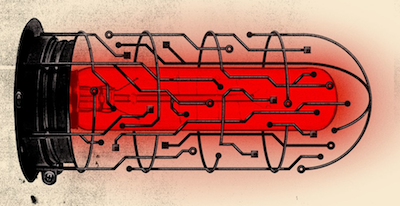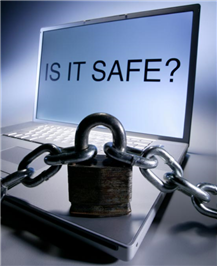Crippled ports. Paralyzed corporations. Frozen government agencies. How a single piece of code crashed the world.
Across the street, an IT administrator named Henrik Jensen was working in another part of the Maersk compound, an ornate white-stone building that in previous centuries had served as the royal archive of maritime maps and charts. (Henrik Jensen is not his real name. Like almost every Maersk employee, customer, or partner I interviewed, Jensen feared the consequences of speaking publicly for this story.) Jensen was busy preparing a software update for Maersk’s nearly 80,000 employees when his computer spontaneously restarted.
He quietly swore under his breath. Jensen assumed the unplanned reboot was a typically brusque move by Maersk’s central IT department, a little-loved entity in England that oversaw most of the corporate empire, whose eight business units ranged from ports to logistics to oil drilling, in 574 offices in 130 countries around the globe.
Jensen looked up to ask if anyone else in his open-plan office of IT staffers had been so rudely interrupted. And as he craned his head, he watched every other computer screen around the room blink out in rapid succession.
“I saw a wave of screens turning black. Black, black, black. Black black black black black,” he says. The PCs, Jensen and his neighbors quickly discovered, were irreversibly locked. Restarting only returned them to the same black screen.
About the Author
Andy Greenberg (@a_greenberg) is a WIRED senior writer. This story is excerpted from his book Sandworm, forthcoming from Doubleday.
All across Maersk headquarters, the full scale of the crisis was starting to become clear. Within half an hour, Maersk employees were running down hallways, yelling to their colleagues to turn off computers or disconnect them from Maersk’s network before the malicious software could infect them, as it dawned on them that every minute could mean dozens or hundreds more corrupted PCs. Tech workers ran into conference rooms and unplugged machines in the middle of meetings. Soon staffers were hurdling over locked key-card gates, which had been paralyzed by the still-mysterious malware, to spread the warning to other sections of the building.
Disconnecting Maersk’s entire global network took the company’s IT staff more than two panicky hours. By the end of that process, every employee had been ordered to turn off their computer and leave it at their desk. The digital phones at every cubicle, too, had been rendered useless in the emergency network shutdown.
Around 3 pm, a Maersk executive walked into the room where Jensen and a dozen or so of his colleagues were anxiously awaiting news and told them to go home. Maersk’s network was so deeply corrupted that even IT staffers were helpless. A few of the company’s more old-school managers told their teams to remain at the office. But many employees—rendered entirely idle without computers, servers, routers, or desk phones—simply left.
Jensen walked out of the building and into the warm air of a late June afternoon. Like the vast majority of Maersk staffers, he had no idea when he might return to work. The maritime giant that employed him, responsible for 76 ports on all sides of the earth and nearly 800 seafaring vessels, including container ships carrying tens of millions of tons of cargo, representing close to a fifth of the entire world’s shipping capacity, was dead in the water.
NotPetya was propelled by two powerful hacker exploits working in tandem: One was a penetration tool known as EternalBlue, created by the US National Security Agency but leaked in a disastrous breach of the agency’s ultrasecret files earlier in 2017. EternalBlue takes advantage of a vulnerability in a particular Windows protocol, allowing hackers free rein to remotely run their own code on any unpatched machine.
NotPetya’s architects combined that digital skeleton key with an older invention known as Mimikatz, created as a proof of concept by French security researcher Benjamin Delpy in 2011. Delpy had originally released Mimikatz to demonstrate that Windows left users’ passwords lingering in computers’ memory. Once hackers gained initial access to a computer, Mimikatz could pull those passwords out of RAM and use them to hack into other machines accessible with the same credentials. On networks with multiuser computers, it could even allow an automated attack to hopscotch from one machine to the next.
Before NotPetya’s launch, Microsoft had released a patch for its EternalBlue vulnerability. But EternalBlue and Mimikatz together nonetheless made a virulent combination. “You can infect computers that aren’t patched, and then you can grab the passwords from those computers to infect other computers that are patched,” Delpy says.
NotPetya took its name from its resemblance to the ransomware Petya, a piece of criminal code that surfaced in early 2016 and extorted victims to pay for a key to unlock their files. But NotPetya’s ransom messages were only a ruse: The malware’s goal was purely destructive. It irreversibly encrypted computers’ master boot records, the deep-seated part of a machine that tells it where to find its own operating system. Any ransom payment that victims tried to make was futile. No key even existed to reorder the scrambled noise of their computer’s contents.
The weapon’s target was Ukraine. But its blast radius was the entire world. “It was the equivalent of using a nuclear bomb to achieve a small tactical victory,” Bossert says.
The release of NotPetya was an act of cyberwar by almost any definition—one that was likely more explosive than even its creators intended. Within hours of its first appearance, the worm raced beyond Ukraine and out to countless machines around the world, from hospitals in Pennsylvania to a chocolate factory in Tasmania. It crippled multinational companies including Maersk, pharmaceutical giant Merck, FedEx’s European subsidiary TNT Express, French construction company Saint-Gobain, food producer Mondelēz, and manufacturer Reckitt Benckiser. In each case, it inflicted nine-figure costs. It even spread back to Russia, striking the state oil company Rosneft.
The result was more than $10 billion in total damages, according to a White House assessment confirmed to WIRED by former Homeland Security adviser Tom Bossert, who at the time of the attack was President Trump’s most senior cybersecurity-focused official. Bossert and US intelligence agencies also confirmed in February that Russia’s military—the prime suspect in any cyberwar attack targeting Ukraine—was responsible for launching the malicious code. (The Russian foreign ministry declined to answer repeated requests for comment.)
To get a sense of the scale of NotPetya’s damage, consider the nightmarish but more typical ransomware attack that paralyzed the city government of Atlanta this past March: It cost up to $10 million, a tenth of a percent of NotPetya’s price. Even WannaCry, the more notorious worm that spread a month before NotPetya in May 2017, is estimated to have cost between $4 billion and $8 billion. Nothing since has come close. “While there was no loss of life, it was the equivalent of using a nuclear bomb to achieve a small tactical victory,” Bossert says. “That’s a degree of recklessness we can’t tolerate on the world stage.”
In the year since NotPetya shook the world, WIRED has delved into the experience of one corporate goliath brought to its knees by Russia’s worm: Maersk, whose malware fiasco uniquely demonstrates the danger that cyberwar now poses to the infrastructure of the modern world. The executives of the shipping behemoth, like every other non-Ukrainian victim WIRED approached to speak about NotPetya, declined to comment in any official capacity for this story. WIRED’s account is instead assembled from current and former Maersk sources, many of whom chose to remain anonymous.
But the story of NotPetya isn’t truly about Maersk, or even about Ukraine. It’s the story of a nation-state’s weapon of war released in a medium where national borders have no meaning, and where collateral damage travels via a cruel and unexpected logic: Where an attack aimed at Ukraine strikes Maersk, and an attack on Maersk strikes everywhere at once.
Continue reading HERE.




